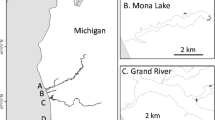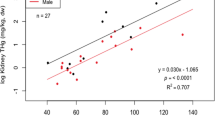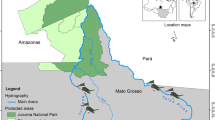Abstract
We assessed the distribution of mercury in snapping turtles(Chelydra serpentina) by analyzing front shoulder muscle,back leg muscle, tail muscle, blood, liver, and marginalcarapacial scute (shell) of 26 adult turtles from five smalllakes. Total mercury concentration in muscle ranged from 50 to500 ng g−1 wet weight and was highly correlated among the threetissue locations. There was no relationship between musclemercury concentration and body size. Mercury concentration inblood was similar to muscle; the correlation with muscle mercuryconcentration was significant but there was some variability. Mercury concentration in shell was much higher than in muscle orblood, ranging from 500 to 3300 ng g−1, and was highly correlatedwith muscle mercury concentration. Liver mercury concentrationwas similar to shell, but was highly variable and uncorrelatedwith any other tissue. We conclude that snapping turtlesaccumulate mercury from their environment and may be usefulmonitors of mercury contamination.
Similar content being viewed by others
REFERENCES
Albers, P., Sileo, L. and Mulhern, B.: 1986, ‘Effects of environmental contaminants on snapping turtles of a tidal wetland’, Arch. Environ. Contam. Toxicol. 15, 39–49.
Ballatori, N. and Boyer, J.: 1986, ‘Slow biliary elimination of methyl mercury in the marine elasmobranchs, Raja erinacea and Squalus acanthias’, Toxicol. Appl. Pharmacol. 85, 407–415.
Clarkson, T., Hursh, J., Sager, P. and Syversen, T.: 1988, ‘Mercury’ in T. Clarkson, L. Friberg, G. Nordberg, and P. Sager(eds.), Biological Monitoring of Toxic Metals, Plenum Press, New York, pp. 199–246.
Downs, S., MacLeod, C. and Lester, J.: 1998, ‘Mercury in precipitation and its relation to bioaccumulation in fish: a literature review’, Water, Air, and Soil Pollut. 108, 149–187.
Ernst, C. and Barbour, R.: 1989, Turtles of the World, Smithsonian Institution Press, Washington, District of Columbia.
Giblin, F. and Massaro, E.: 1973, ‘Pharmacodynamics of methyl mercury in the rainbow trout (Salmo gairdneri): Tissue uptake, distribution, and excretion’, Toxicol. Appl. Pharmacol. 24, 81–91.
Greib, T., Driscoll, C., Gloss, S., Schofield, C., Bowie, G. and Porcella, D.: 1990, ‘Factors affecting mercury accumulation in fish in the Upper Michigan Peninsula',Environ. Toxicol. Chem. 9, 919–930.
Haines, T., Komov, V., Matey, V. and Jagoe, C.: 1995, ‘Perch mercury content is related to acidity and color of 26 Russian lakes’, Water, Air, and Soil Pollut. 85, 823–828.
Hanten, R., Neumann, R., Ward, S., Carley, R., Perkins, C. and Pirrie, R.: 1998, ‘Relationships between concentrations of mercury in largemouth bass and physical and chemical characteristics of Connecticut lakes’, Trans. Am. Fish. Soc. 127, 807–818.
Heaton-Jones, T., Homer, B., Heaton-Jones, D. and Sundlof, S.: 1997, ‘Mercury distribution in American alligators (Alligator mississippiensis) in Florida’, J. Zoo Wildl. Med. 28, 62–70.
Heinz, G., Haseltine, S., Hall, R. and Krynitsky, A.: 1980, ‘Organochlorine and mercury residues in snakes from Pilot and Spider Islands, Lake Michigan – 1978’, Bull. Environ. Contam. Toxicol. 25, 738–743.
Helwig, D. and Hora, M.: 1983, ‘Polychlorinated biphenyl, mercury, and cadmium concentrations in Minnesota snapping turtles’, Bull. Environ. Contam. Toxicol. 30, 186–190.
Lindqvist, O., Johansson, K., Aastrup, M., Andersson, A., Bringmark, L., Hovsenius, G., Hakanson, L., Iverfeldt, A., Meili, M. and Timm, B.: 1991, ‘Mercury in the Swedish environment – recent research on causes, consequences and corrective methods’, Water, Air, and Soil Pollut. 55, 1–261.
Magos, L.: 1987, ‘The Absorption, Distribution, and Excretion ofMethyl Mercury’, in C. Eccles, and Z. Annau (eds.), The Toxicity ofMethylMercury, The Johns Hopkins University Press, Baltimore, Maryland, pp. 24–44.
Meyers-Schöne, L., Shugart, L., Beauchamp, J. and Walton, B.: 1993, ‘Comparison of two freshwater turtle species as monitors of radio nuclide and chemical contamination: DNA damage and residue analysis’, Environ. Toxicol. Chem. 12, 1487–1496.
Monteiro, L. and Furness, R.: 1995, ‘Seabirds as monitors of mercury in the marine environment’, Water, Air, and Soil Pollut. 80, 851–870.
Monteiro, L. and Furness, R.: 1997, ‘Accelerated increase in mercury contamination in North Atlantic mesopelagic food chains as indicated by time series of seabird feathers’, Environ. Toxicol. Chem. 16, 2489–2493.
Morel, F., Kraepiel, A. and Amyot, M.: 1998, ‘The chemical cycle and bioaccumulation of mercury’, Ann. Rev. Ecol. Syst. 29, 543–566.
Rose, J., Hutcheson, M., West, C., Pancorbo, O., Hulme, K., Cooperman, A., DeCesare, G., Isaac, R. and Screpetis, A.: 1999, ‘Fish mercury distribution in Massachusetts, U.S.A. lakes’, Environ. Toxicol. Chem. 18, 1370–1379.
Stafford, C. and Haines, T.: 1997, ‘Mercury concentrations in Maine sport fishes’, Trans. Am. Fish. Soc. 126, 144–152.
Suzuki, T.: 1988, ‘Hair and Nails: Advantages and Pitfalls when used in Biological Monitoring’, in T. Clarkson, L. Friberg, G. Nordberg, and P. Sager (eds.), Biological Monitoring of Toxic Metals, Plenum Press, New York, pp. 623–640.
Author information
Authors and Affiliations
Corresponding author
Rights and permissions
About this article
Cite this article
Golet, W.J., Haines, T.A. Snapping Turtles (Chelydra serpentina) As Monitors for Mercury Contamination of Aquatic Environments. Environ Monit Assess 71, 211–220 (2001). https://doi.org/10.1023/A:1011802117198
Issue Date:
DOI: https://doi.org/10.1023/A:1011802117198




